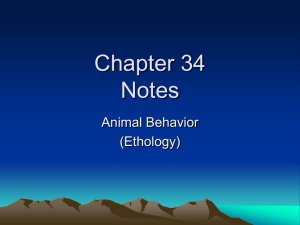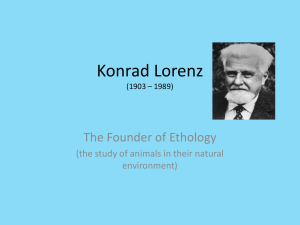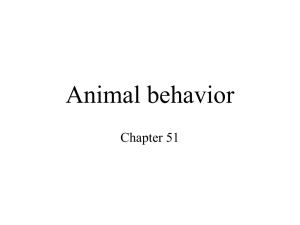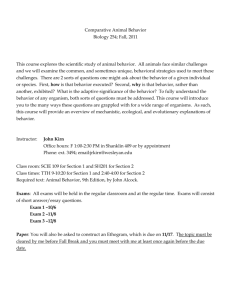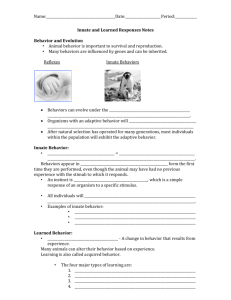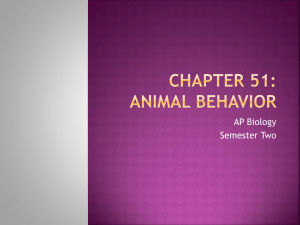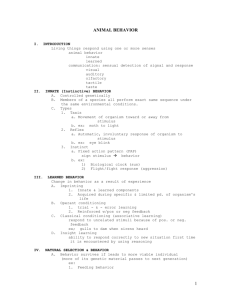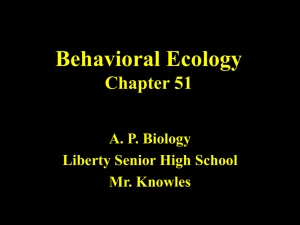Animal Behavior
advertisement
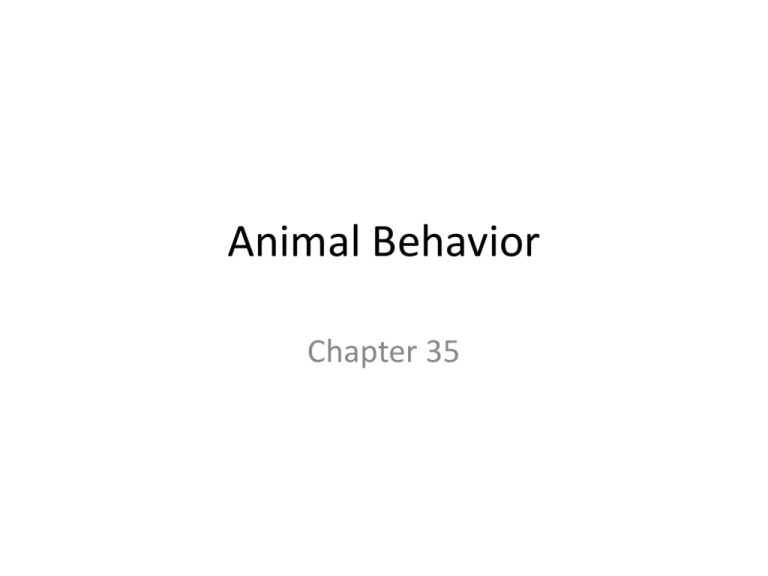
Animal Behavior Chapter 35 What is Behavior? • Responses of animals to environmental cues – What and why it is done • Controlled by nervous and endocrine systems • Some are innate – Heritable, stereotypic, and intrinsic – Orb spider webs and newborn reflexes • Some are learned – Nonheritable, adaptable, and extrinsic – Bird song and migration patterns Karl von Frisch • Initial use of experimental methods in behavior • Studied senses of bees • Identified bee communication – Translated meaning of the waggle dance – Length and number of waggles = distance – Angle of waggle run to vertical of hive = angle of food from sun Konrad Lorenz • Founder of behavioral behavior • Studied instinctive behavior in animals – Principle of imprinting in ground nesting birds – Greylag geese experiment Nikolass (Niko) Tinbergen • Originated 4 questions to ask about any behavior • • • • Causation what are the proximate causes? Development what is the ontogeny/development? Function what is the survival value? Evolution what is the evolutionary history? • Cornerstone of modern ethology • Worked with Lorenz on fixed action patterns Studying Animal Behavior • Proximate causes examine HOW an animal behaves – Factors behind a biological system working at a particular time and place – Mechanisms and structures within an animal that produce the behavior • Ultimate causes examine WHY they behave that way – Identify and reconstruct evolutionary history of the behavior – Purpose of this behavior – Evolution of the behavior – Adaptability of the behavior Innate Behaviors • Programmed by genes • Highly stereotyped • Four categories – Kinesis: random movement in response to stimulus • Sow bugs (pill bugs) movement to water – Taxis: deliberate movement toward or away from a stimulus • Stream fish face upstream for food – Reflex – Fixed action pattern (FAP) Taxis Fixed Action Patterns • Stereotyped, often complex series of movements – Response to a specific stimulus = ‘releaser’ – Fully functional 1st time performed • Completed fully once started – Not modified by experience • E.g.: suckling behavior of newborns egg retrieval of graylag goose courtship rituals yawning Learned Behavior • Acquired during an animal’s lifetime • Modified by experiences • Categories – – – – – Imprinting Habituation Associative learning Problem solving Spatial learning • Cognitive mapping – Social learning Imprinting • Occurs during a ‘sensitive’ or ‘critical’ development period • Imprinting of baby geese on mother was studied by Konrad Lorenz Habituation • Decline in response to a harmless, repeated stimulus • Acts as a filter – Prevents wasting energy on irrelevant stimuli • Adaptive Prairie dog warning calls decrease when homes near human populations Associative Learning • Forms association between 2 stimuli • Classical conditioning – Animal learns to perform old response to new stimulus • Stimulus 1st, behavior 2nd • Pavlov’s dogs • Operant conditioning – Trial-and-error learning – Perform behavior to receive reward or avoid punishment • Behavior 1st, reward 2nd • Clicker training Problem Solving • Manipulate concepts to arrive at an adaptive behavior • Internal memory used as additional sensory/information source • Mental trial-and-error Spatial Learning • Enables an animal to learn and use information about its physical environment – Bees and wasps use to locate nest • Tinbergen used digger wasp nests to test • Cognitive mapping – Internal representation of spatial relationships in an animal’s surroundings – Examples • Bird food storage caches • Migration – Piloting and homing animals find their way by orienting to these landmarks Social Learning • Involves observing and imitating members of the same species – Food washing in Japanese macques • Female learns and imitated by younger group members – Calling by vervet monkeys • Young vs adult • Eagle vs snake vs any flying animal Individual Behavior • Foraging – – – – Eating Searching Recognizing Capturing • Communication – – – – Prairie dog searches for food in the winter Visual Auditory Chemical Tactile • Moving • Grooming Warning coloration: behave conspicuously to further announce they are dangerous prey Social Behavior • Involves interactions with members of the same species • Types – Affiliative: promote group cohesion – Agonistic (aggressive) • Territorality • Dominance – Reproductive – Parental • Advantages – – – – Hunting efficiency Protection from predators Energy conservation Access to mates • Disadvantages – – – – Increased competition within group Increased risk of infection Risk offspring being killed by group Risk of being spotted by predators An aggregation of ladybird beetles Male impalas rubbing heads, exchange scents and establish relationships Male lion with his pride Agonistic Behavior • Occur over limited resources • Threats, displays, or combat – Displays often to minimize injury • Reinforce social hierarchy – Stable for periods of time Silverback male mountain gorilla – Alpha individual and others understand position Territoriality • Establishing and maintaining a space • Requires maintenance of boundaries – Olfactory marking – Singing – Occasional physical interactions • Size of territory depends on required maintenance • Access to resources and mates Sexual Reproduction • Requires communication – Stereotyped displays (FAPs) – Sexual dimorphism – Pheromones • Conditions for success – Identify species – Identify opposite sex – Identify availability • Mating systems – Promiscuous – Monogamous – Polygamous Parental Behavior • Approaches and care for young – Maternal, paternal, both, or none • Defense – Maternal aggression • Offspring or conspecifics • Feeding • Nest building What is an Ethogram? • List of natural behaviors in an animal – Can be individual or social – Based on natural or semi-natural environmental observations • Distinguishes frequencies and durations of behaviors – Seasonal and geographic effects – Gender and development effects Preparing an Ethogram • List different behaviors expected to see – Organize into types • Solitary or social • Food or reproductive related • Affiliative or aggressive – Multiple individuals need identification codes • Prepare a chart to allow monitoring – Break into a given time increment (1-2 minutes good) – Record everything done as checks and/or letter designator for each period • Glossary explains detailed behaviors for other observers to interpret Sample Ethogram Glossary Type of Behavior Behavior Code Description of Behavior Solitary Groom self GS Animal engages in washing or smoothing its own fur or hair using tongue or forelimbs Sleep S Animal assumes specie-specific position for sleep, stays on one place and is not alert to environmental changes Rest R Animal stays in one place but may be roused easily by environmental changes Locomote L Animal moves from place to place Eat E Animal consumes food it finds in its environment Look for food LF Animal searches the environment for food items Drink D Animal consumes water or other liquids found in its environment Groom others GO Animal engages in washing or smoothing the fur or hair of another animal in its environment Play P Animal engages in interactions with others that may involve locomotion, climbing, manipulating objects or other activities that show a relationship between two or more interacting animals Fight F Animal engages in physical conflict with another animal in its environment Steal food SF Animal approaches another animal that has located food in the environment and either by physical force or distraction, removes the food item form the vicinity of the other animal Food Related Social Aggressive Sample Ethogram
